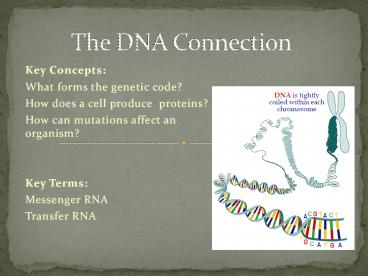Key Concepts: - PowerPoint PPT Presentation
Title:
Key Concepts:
Description:
Key Concepts: What forms the genetic code? How does a cell produce proteins? How can mutations affect an organism? Key Terms: Messenger RNA Transfer RNA – PowerPoint PPT presentation
Number of Views:60
Avg rating:3.0/5.0
Title: Key Concepts:
1
The DNA Connection
- Key Concepts
- What forms the genetic code?
- How does a cell produce proteins?
- How can mutations affect an organism?
- Key Terms
- Messenger RNA
- Transfer RNA
2
The Genetic Code
- Main function of genes is to control the
production of proteins - Genes and DNA Chromosomes
- are made of DNA.
- Genes are sections of a DNA molecule that codes
for one specific protein. May contain several
hundred to a million or more base pairs (Ex.
AGGTCACGAATTTTCCGG)
3
Order of Bases
- The order of the nitrogen bases along a gene
forms a genetic code that specifies what type of
protein will be produced. - Proteins are made of amino acids A group of 3
base pairs codes for a specific amino acid - Ex. CGT alanine (an amino acid)
- The order of the 3 base code units determines the
order of the amino acids and makes the different
proteins
4
(No Transcript)
5
How Cells Make Proteins(Protein Synthesis)
- The Role of RNA
- Protein synthesis takes place on ribosome in
cytoplasm - RNA acts as a messenger to take the DNAs
information in the chromosomes to the ribosomes
in the cytoplasm - RNA similar to DNA, yet different in some key
ways - single strand
- ribose sugar
- Bases same - adenine, guanine and cytosine
- different uracil instead of thymine
6
(No Transcript)
7
Types of RNA
- Messenger RNA copies code from DNA in the
nucleus and carries message to ribosomes in the
cytoplasm - Transfer RNA carries amino acids to ribosome
and adds them to the growing protein molecule
8
Translating the Code
- First Step
- 1. DNA molecule unzips between base pairs
- 2. DNA directs the production of a strand of
messenger RNA - 3. To form the RNA strand RNA bases pair with
DNA bases. Guanine with Cytosine, but uracil
pairs with adenine instead of Thymine
9
Translating the Code
- Second step
- 1. Messenger RNA leaves nucleus and attaches to
a ribosome in the cytoplasm - 2. Messenger RNA provides the code to make the
protein molecule - 3. The ribosome moves along the messenger RNA
strand
10
(No Transcript)
11
Translating the Code
- Third Step
- 1. Molecules of transfer RNA attach to messenger
RNA - 2. Bases of transfer RNA read the message by
pairing up 3-letter codes to bases of messenger
RNA - 3. Molecules of transfer RNA carry specific
amino acids that link in a chain - 4. Order of amino acids is determined by order
of 3-letter code on messenger RNA
12
(No Transcript)
13
Translating the Code
- Fourth Step
- 1. Protein molecule grows longer as each
transfer RNA adds an amino acid - 2. When done the transfer RNA is released into
the cytoplasm and can pick up another amino acid - 3. Each transfer amino acid picks up the same
type of amino acid
14
(No Transcript)
15
Mutations
- A mutation is any change in a gene or chromosome
- Mutations can cause a cell to produce an
incorrect protein during protein synthesis. - As a result of a mutation, the organisms trait
or phenotype, may be different from what it
normally would have been - If a mutation is in a body cell, it will not be
passed on to the offspring. If it is a sex cell,
it can be passed on and can affect the
offsprings phenotype
16
Substitution
Insertion
Deletion
17
Types of Mutations
- Some mutations happen during DNA Replication
- A single base may be substituted for another
- One or more bases may be removed from a section
of DNA or new bases inserted - Some mutations happen during Meiosis
- Chromosomes dont separate correctly
- Cell can end up with too many or too few
chromosomes - Cell could end up with fragments of chromosomes
18
(No Transcript)
19
Effects of Mutations
- Mutations introduce change in an organism and so
are a source of - genetic variety
- Some mutations are harmful,
- some are helpful, and some dont affect the
organism - Whether a mutation is harmful or not depends
partly on the environment - A mutation causing an albino animal in the wild
would be harmful, but if the animal lived in the
zoo, it would not matter
20
Effects of Mutations
- Helpful mutations improve an organisms chances
for survival and reproduction - Ex. Bacteria that have mutations that have given
them resistance to antibiotics are more likely
to survive and reproduce
21
(No Transcript)
22
Credits
- http//www.sciencewithmrmilstid.com/media/chromoso
malDNA.png - http//www.medceu.com/images/molecularmachine.jpg
- http//www.accessexcellence.org/RC/VL/GG/images/pr
otein_synthesis.gif - http//faculty.irsc.edu/FACULTY/TFischer/bio2012
0files/protein20synthesis20overview.jpg - http//www.nature.com/scitable/content/ne0000/ne00
00/ne0000/ne0000/6632005/EssGen_BaseSubstitutionFi
g1_MID_0.jpg































